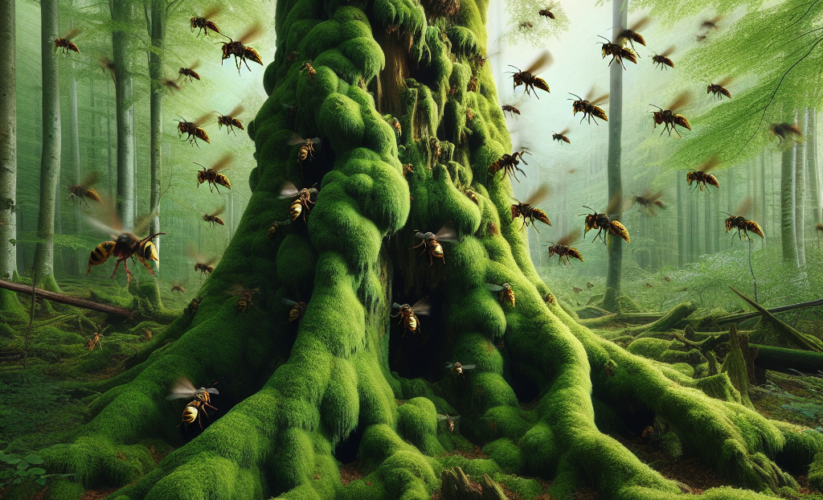
Unlock the Secret to Hornissenschimmel: 5 Proven Solutions
Hornissenschimmel: Understanding This Unique Fungal Growth
When discussing the intriguing world of fungi, **hornissenschimmel** (also known as hornet mold) often captures attention due to its distinctive appearance and ecological role. In this article, we will delve deep into the characteristics, significance, and management of hornissenschimmel.
The Characteristics of Hornissenschimmel
Hornissenschimmel possesses unique features that set it apart from other molds. This species typically exhibits a yellowish to light brown coloration and grows in irregular patches. The texture can range from fuzzy to sticky, depending on moisture levels and environmental conditions. Hornissenschimmel thrives in damp areas, often found on organic materials such as wood, soil, and plant debris. Its presence is a natural part of the ecosystem, where it plays a critical role in decomposing organic matter, thus contributing to nutrient cycling.

The process of spore production in hornissenschimmel is fascinating; it releases spores into the air, aiding in species propagation. The spores can travel significant distances, making it adaptable to various environments. It is essential to recognize the conditions under which this mold flourishes. Ideal conditions consist of high humidity and moderate temperatures, which align with natural habitats found in forests and wetlands. Understanding these characteristics helps in appreciating the ecological niche hornissenschimmel fills.
Ecological Role of Hornissenschimmel
The role of hornissenschimmel in ecosystems cannot be understated. As a decomposer, it contributes to breaking down dead organic matter, which in turn enriches the soil. This process supports plant growth, making it a vital part of the food web.
For example, hornissenschimmel aids in decomposing fallen leaves and wood, which release nutrients back into the soil. As such, it is crucial for maintaining soil health and fertility. Furthermore, hornissenschimmel provides a habitat for various microorganisms and insects, promoting biodiversity.
Impact on Human Structures
While hornissenschimmel is a natural part of outdoor ecosystems, it can pose challenges when it infiltrates human structures. Homes and buildings with high humidity levels are particularly susceptible to mold growth. In such cases, hornissenschimmel can compromise the integrity of materials by breaking down wood and other organic substrates.
Homeowners should be vigilant about moisture control to prevent mold issues. Regular inspections and maintenance of basements, attics, and bathrooms are essential steps in moisture management. If hornissenschimmel is detected, professional removal may be necessary to prevent further damage and maintain a healthy indoor environment.
Health Considerations When Dealing with Hornissenschimmel
Though hornissenschimmel is generally non-toxic, some individuals may experience allergic reactions when exposed to mold spores. Symptoms can include sneezing, coughing, or respiratory issues. It’s crucial to identify hornissenschimmel early to mitigate health risks, especially in sensitive populations, such as children and individuals with pre-existing health conditions.

To minimize potential health impacts, consider implementing the following strategies:
1. **Wear Protective Gear**: When cleaning or disturbing areas with hornissenschimmel, it’s advisable to wear masks and gloves to minimize spore inhalation and skin contact.
2. **Control Humidity**: Utilizing dehumidifiers and ensuring proper ventilation can help reduce moisture levels and discourage mold growth.
3. **Seek Professional Help**: If mold exposure is suspected to cause health issues, consulting with a healthcare provider and a mold remediation specialist is crucial.
Preventive Measures Against Hornissenschimmel
Preventing hornissenschimmel growth in your home or garden involves proactive moisture management. Here are some actionable steps:
– **Regular Cleaning**: Keep areas prone to moisture, such as bathrooms, kitchens, and basements, clean and dry.
– **Repair Leaks**: Address any leaks in roofs, plumbing, or walls to prevent water accumulation.
– **Improve Air Circulation**: Use fans or air conditioning to enhance airflow in damp areas.
These strategies not only help with preventing hornissenschimmel but also contribute to a healthier living environment overall.
Removing Hornissenschimmel Effectively
If hornissenschimmel becomes a problem, timely removal is crucial. Here are the steps for effective mold remediation:
1. **Identify and Control Moisture Sources**: Find the source of dampness and fix it to prevent recurrence.
2. **Apply Mold-Killing Solutions**: Use commercial mold removal products or a mixture of water and vinegar to treat affected areas.
3. **Ensure Proper Disposal**: Dispose of contaminated materials safely to prevent spreading spores.
Following these steps can help restore areas affected by hornissenschimmel, ensuring safety and comfort.
Understanding the Life Cycle of Hornissenschimmel
The life cycle of hornissenschimmel includes several stages: spore germination, mycelium growth, and reproduction. Initially, spores germinate in moist conditions, leading to the formation of hyphal networks, which spread through the substrate. Over time, as it matures, hornissenschimmel produces spores, completing the cycle.

Understanding this life cycle can help in predicting outbreaks and managing hornissenschimmel-related issues effectively. Recognizing the signs of growth, such as discoloration or musty odors, can lead to early interventions, making the management process significantly easier.
Environmental Factors Influencing Growth
Various factors influence the growth and development of hornissenschimmel. Temperature, humidity, and substrate type are critical. For example, warmer temperatures coupled with high humidity levels provide ideal conditions for rapid growth, especially in the spring and fall. Additionally, certain materials, like untreated wood or fallen leaves, serve as nutrient-rich substrates, promoting thriving populations.
Case Study: Hornissenschimmel in Urban Areas
A notable case study involving hornissenschimmel occurred in an urban setting where multiple households reported outbreaks after heavy rainfall. Research indicated that the homes with poor ventilation and high moisture levels experienced significant hornissenschimmel growth. Residents were educated about moisture management, leading to reduced incidents and enhanced community awareness about mold prevention.
Key Takeaways
– **Understand Characteristics**: Recognizing hornissenschimmel and its ecological role is vital for managing its presence.
– **Health Risks**: Although generally safe, hornissenschimmel can pose health risks, especially in sensitive individuals.
– **Effective Remediation**: Timely intervention and proper removal methods are essential for managing hornissenschimmel.
– **Prevention is Key**: Proactive moisture control and preventive measures help mitigate the risks associated with hornissenschimmel.
FAQ
1. What is hornissenschimmel and where is it commonly found?
Hornissenschimmel is a type of mold that typically thrives in damp environments such as forests, wetlands, and poorly ventilated indoor spaces. It plays a pivotal role in decomposing organic matter and enriching soil, contributing to the ecosystem’s health.
2. How does hornissenschimmel affect indoor air quality?
While generally non-toxic, hornissenschimmel can release spores that may affect indoor air quality, particularly for sensitive individuals. Prolonged exposure can lead to respiratory issues and allergic reactions, making it important to manage moisture in indoor spaces.
3. Are there any natural remedies for removing hornissenschimmel?
Yes, natural remedies include vinegar, baking soda, and tea tree oil. These substances can effectively inhibit mold growth when applied to contaminated areas. However, it’s essential to address moisture issues along with treatment to prevent recurrence.
4. Can hornissenschimmel cause structural damage?
Yes, hornissenschimmel can cause structural damage when it feeds on organic materials like wood. It is crucial to address any mold growth promptly to prevent costly repairs and maintain structural integrity.
5. What preventive measures can be taken to avoid hornissenschimmel growth?
To prevent hornissenschimmel growth, maintain low humidity levels, ensure good ventilation, repair leaks, and keep areas clean and dry. Regular maintenance controls moisture, which is vital for mold prevention.
6. How can I recognize hornissenschimmel in my home?
Look for visible signs of mold growth such as discoloration on walls or ceilings, musty odors, or damp spots, especially in basements, kitchens, or bathrooms where humidity is often high.
7. Should I hire a professional for hornissenschimmel removal?
If you have extensive mold growth or health concerns, it’s advisable to hire a professional mold remediation service. They can safely remove the mold and provide solutions to manage moisture levels in your home.